Hello, curious parents and little artists! Are you ready to embark on a colorful adventure? Today, we’re talking about a magical activity that can transform your usual afternoons into a canvas of colors and creativity: Flower Coloring Pages!
Now, you might be thinking, ‘What’s so special about coloring flowers?’ Well, I’m glad you asked! As someone who has spent over a decade swimming in the sea of children’s art and craft, I can tell you that there’s more to these pretty petals and leaves than meets the eye. Coloring is not just about staying within the lines; it’s a journey of exploration, learning, and emotional growth for your little ones.
Let’s face it, in this fast-paced digital world, it’s easy to hand over a tablet to keep our kids busy. But what if I told you that the humble coloring page could be your new best friend? Yes, flower coloring pages are like secret gardens waiting to be discovered, each bloom offering a new lesson, a new story.
From enhancing fine motor skills to sparking imagination, these pages are not just sheets of paper; they’re gateways to a world of creativity. So, grab your crayons, and let’s dive into this vibrant world of flower coloring pages. Together, we’ll explore why these pages are more than just a pastime and how they can be a blooming part of your child’s development. Ready to color your day with joy? Let’s get started!
Download 20+ Free Printable Flower Coloring Pages for Kids – Click Here
Why Flower Coloring Pages?
Alright, let’s unfold the petals of our first topic: Why opt for flower coloring pages? Now, you might think, ‘It’s just coloring. How special can it be?’ Oh, but there’s a whole bouquet of benefits waiting to be discovered!
The Educational and Emotional Benefits of Coloring
Firstly, flower coloring pages are not just a splash of fun; they are a whirlpool of learning opportunities. When your little artist picks up a crayon to color a daisy or a tulip, they’re not just playing. They’re honing their fine motor skills, you know, those tiny movements in their fingers, hands, and wrists. These skills are super important for things like writing, buttoning up a shirt, or playing the piano. It’s like a mini-workout for their little hands!
But wait, there’s more! Coloring is like a quiet haven for kids. It helps them focus and develops their concentration skills. Picture this: Your child is deciding which shade of pink to use for a rose or whether to color the leaves green or yellow. These decisions boost their decision-making skills and foster creativity. Plus, it’s a great way to express emotions. Feeling happy? Bring on the bright yellows and reds! A bit blue? How about some cool blues and purples?
Enhancing Fine Motor Skills and Concentration
Did you know that every time your child colors, they’re also improving their hand-eye coordination? Yes, it’s true! Trying to keep within the lines might seem simple to us, but for little ones, it’s a challenging task that requires focus and coordination. And guess what? The more they practice, the better they get!
Emotional Expression Through Colors
Let’s not forget the emotional benefits. Coloring provides a sense of calmness and relaxation. Think of it as mindfulness for munchkins. It’s a peaceful activity that can reduce stress and anxiety. Yes, kids experience stress too! When they’re coloring, they’re in their little zen zone, away from the hustle and bustle of the world.
So, there you have it, folks! Flower coloring pages are more than just a way to keep your kids occupied. They’re a fun, educational, and emotionally enriching experience that nurtures your child’s growth in more ways than one. Stay tuned as we blossom into our next section, where we’ll talk about selecting the right flower coloring pages for your budding artist.
Materials and Setup
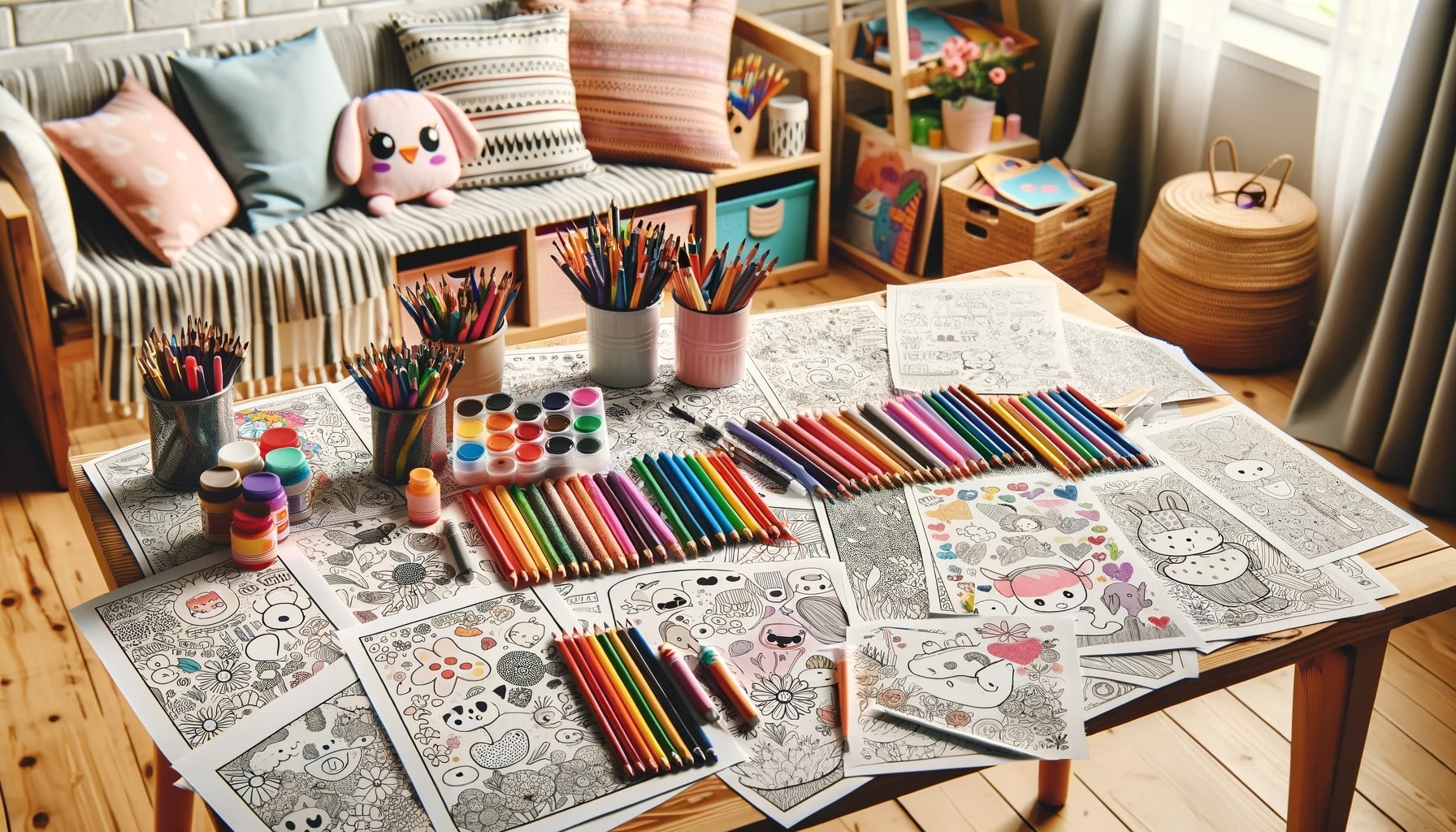
Now that we’ve discovered the wonderful world of flower coloring pages, let’s talk about the artist’s toolbox. Yes, I’m referring to the crayons, markers, and pencils, oh my! And let’s not forget to set up the perfect coloring corner. It’s time to turn your home into an art studio!
Choosing the Best Coloring Tools
First things first: the tools. Just like a chef needs the right ingredients, a little artist needs the right coloring tools. But with so many options, how do you choose?
- Crayons: They’re the classic, aren’t they? Perfect for little hands, crayons are easy to grip and use. They’re great for broad coloring and can take a bit of a beating. Plus, they’re washable, which means less oopsie-daisy moments on the walls.
- Markers: Markers are like the flashy cousins of crayons. They offer bold and vibrant colors that make those flower coloring pages pop! But a word of caution: opt for washable markers, because we all know where those marker tips sometimes end up (hint: not always on the paper).
- Colored Pencils: For the older kids or those with a bit more patience and finesse, colored pencils are wonderful. They’re perfect for adding details and shading to those petals and leaves.
Setting Up a Coloring Workspace
Now, where to color? Any space can become a coloring station, but here are a few tips to make it extra special:
- Find a Bright Spot: Natural light is the best light for coloring. Set up a table near a window where the sun can shine on those masterpieces.
- Keep it Organized: Have a little caddy or a set of bins for coloring tools. This not only keeps things tidy but also teaches your child to take care of their tools.
- Comfort is Key: Make sure the chairs and table are comfortable. We don’t want any sore backs or craning necks.
- Personalize the Space: Let your child decorate their coloring area. Maybe hang up some of their finished coloring pages. It’s their art gallery, after all!
And there you have it! With the right tools and a cozy corner, your little one is all set to bring those flower coloring pages to life.
ALSO READ – 35+ Free Printable Unicorn Coloring Pages for Kids and Adults
A Garden of Coloring Pages – First 5 Blooms
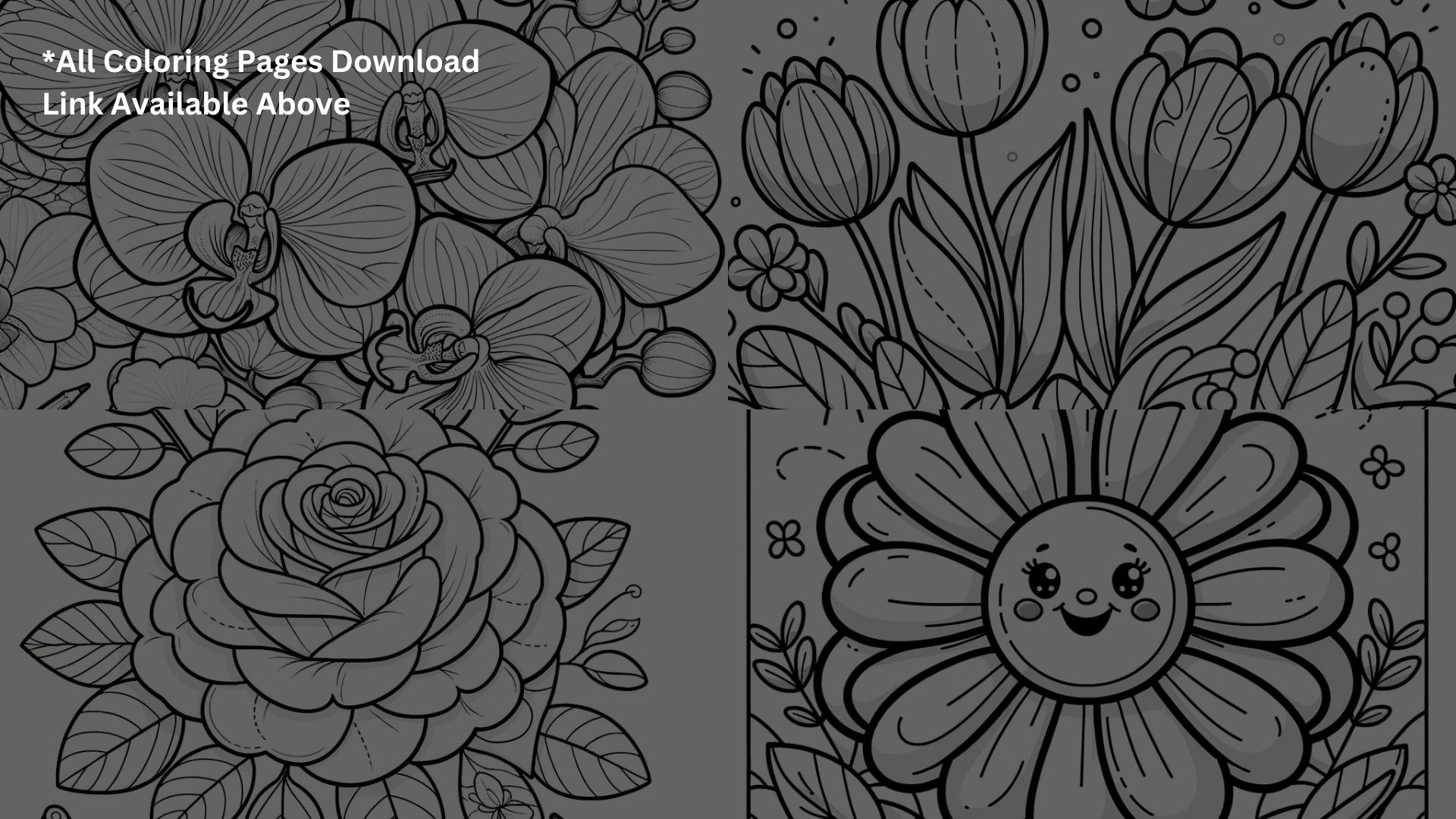
“Step into our virtual garden of coloring pages, where every flower tells a story. In this first part, we’ll introduce the first five blooms of our collection. Each one is unique, offering a different coloring adventure. Let’s meet these floral beauties!
- The Cheerful Daisy: We start with the ever-smiling daisy. It’s simple yet elegant, perfect for younger artists who are just starting to explore the world of colors. Its broad petals offer ample space for coloring, making it a joy to bring to life.
- The Radiant Sunflower: Next up is the sunflower, a giant of the flower world. With its large, circular center and long, narrow petals, this flower is great for practicing patterns and contrasts. Its sunny disposition is sure to brighten any coloring session.
- The Delicate Rose: Ah, the classic rose, a symbol of love and beauty. This one’s a bit more intricate, ideal for kids who want a bit of a challenge. Coloring the overlapping petals can be a delightful exercise in shading and depth.
- The Exotic Orchid: Now, for a touch of the exotic, we have the orchid. Known for its unique shape and vibrant colors, the orchid is a fantastic way to experiment with unusual color combinations and fine details.
- The Playful Tulip: We present the tulip to round off our first set. Its distinct cup-shaped bloom offers a fun coloring experience, perfect for playing with colors and even adding patterns or designs within each petal.
Blooming Creativity – The Next 5 Floral Pages
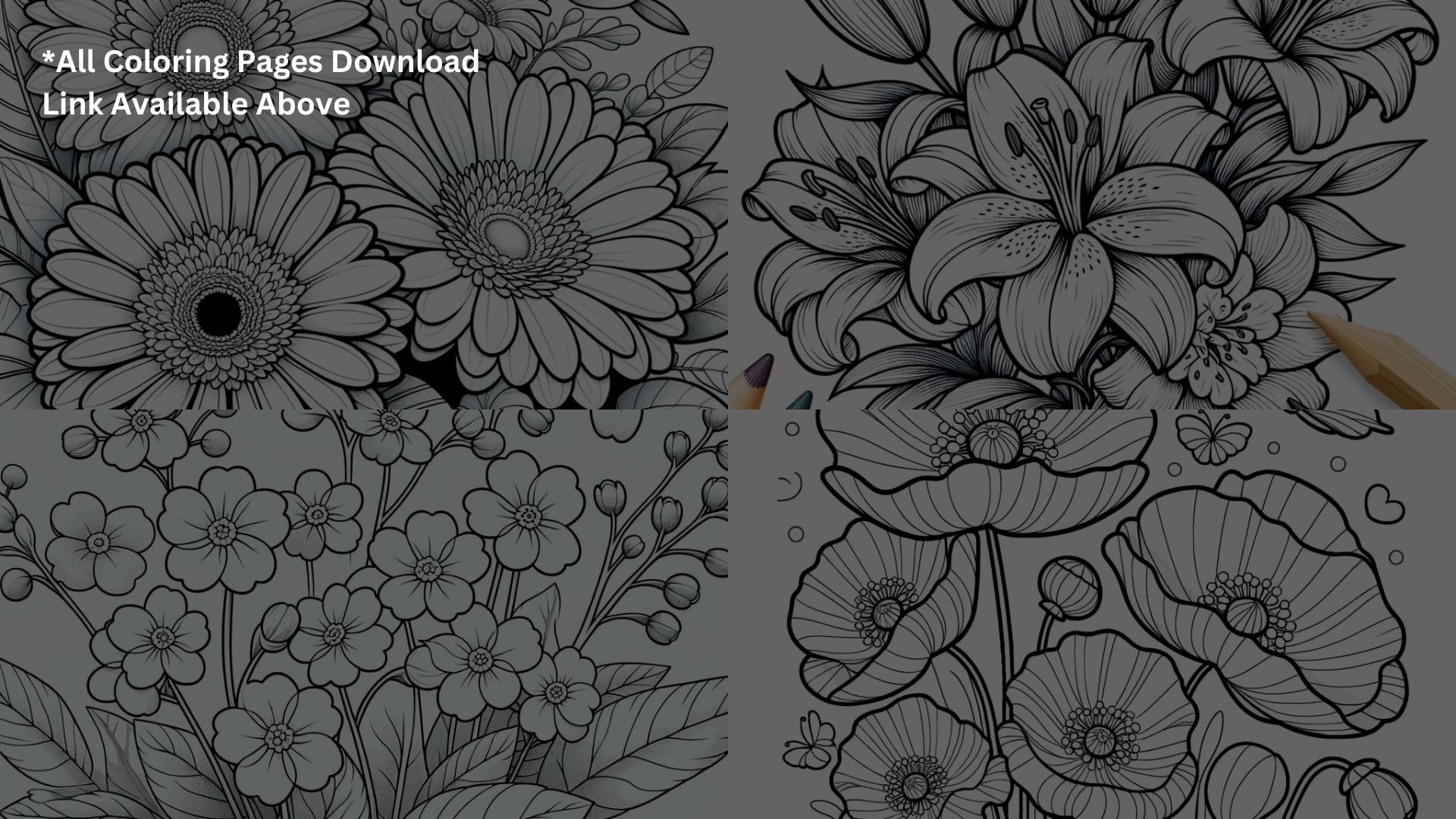
Welcome back to our enchanting garden of flower coloring pages! We’ve already explored five beautiful blooms, and now it’s time to unveil the next five. Each of these pages is a new opportunity for your little artists to express their creativity and learn. Let’s dive into the next set of floral wonders.
- The Lavish Peony: Here we have the peony, with its fluffy, intricate petals. It’s a joy to color, offering a chance to experiment with various shades of pink, red, and even purple. The complexity of the peony is great for older children who enjoy a detailed coloring challenge.
- The Graceful Lily: Next is the elegant lily. Known for its long petals and distinct stamen, the lily page can teach kids about the different parts of a flower. It’s a splendid pick for adding a touch of sophistication to your child’s coloring book.
- The Whimsical Poppy: Don’t forget the poppy, with its thin, delicate petals and a round core. This flower is perfect for playing with bright reds and deep blacks, providing a striking contrast that can stand out in a coloring book.
- The Serene Forget-Me-Not: The small and charming forget-me-not is up next. Its tiny clusters of flowers are wonderful for practicing precision and patience in coloring. Plus, their typically blue color can be a refreshing addition to the palette.
- The Vibrant Gerbera: Rounding off this set is the gerbera, similar to a daisy but with a larger range of colors. This page invites your child to splash in a diverse array of colors, ideal for those who love to make their art bright and cheerful.
Each of these flowers brings its own unique charm and coloring challenges, making them perfect additions to your child’s artistic journey.
Floral Fantasies – Discovering 5 More Coloring Pages
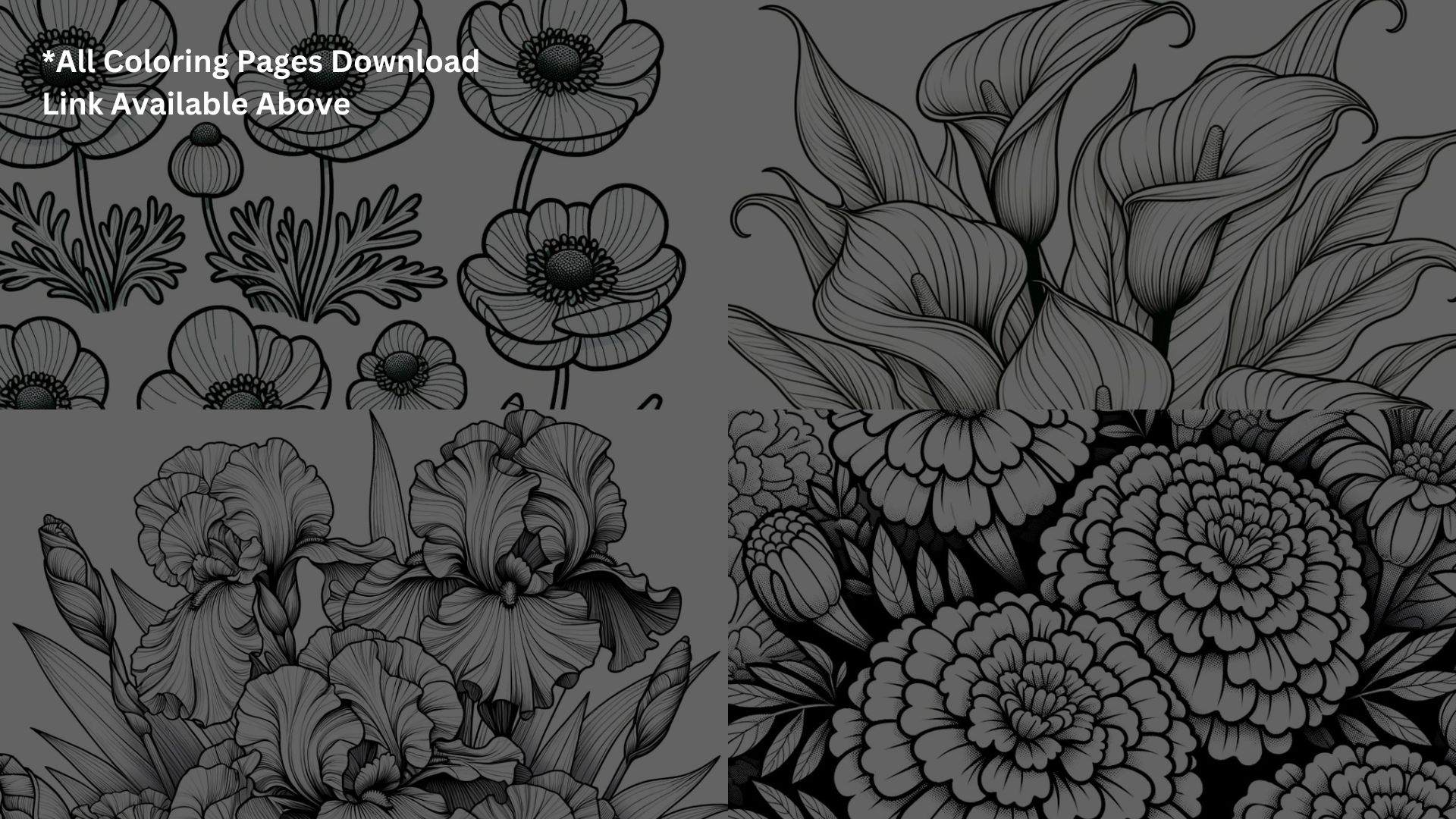
“Hello again, young artists and parents! We’re halfway through our garden of flower coloring pages, and I hope you’re as excited as I am to discover more! Each flower we meet is a new friend, waiting to share its colors and secrets. Let’s unveil the next five floral friends in our coloring adventure.
- The Majestic Iris: Stepping into our third set is the iris, a flower known for its unique shape and striking colors. With its delicate petals and intricate lines, the iris is perfect for those who love to mix and match different shades and practice their blending skills.
- The Dreamy Hydrangea: Up next, is the hydrangea, a cluster of tiny blooms that form a beautiful, large flower head. This page offers a fantastic opportunity to play with gradients, as hydrangeas often blend from one color to another. It’s like a mini-lesson in color theory!
- The Bold Marigold: Say hello to the marigold, a flower as bright and cheerful as a sunny day. Its dense, ruffled petals are a joy to color, especially for those who love vibrant oranges and yellows. It’s a surefire way to add some warmth to your child’s artwork.
- The Elegant Calla Lily: The calla lily, with its smooth, trumpet-like petals, brings a touch of elegance. This page is excellent for exploring shades of white, yellow, and green, providing a more subdued but equally rewarding coloring experience.
- The Quirky Anemone: Last in this set, but certainly not least, is the anemone. This flower often features a dark center with a ring of bright, bold petals around it. It’s a wonderful choice for experimenting with contrasts and creating a piece of art that pops!
Each of these flowers is not just a page to color, but a story to tell and a skill to learn. Whether it’s blending, contrasting, or simply enjoying the array of colors, these pages are sure to add to your child’s creative journey.
Blossoms – Completing Our 20 Flower Coloring Pages
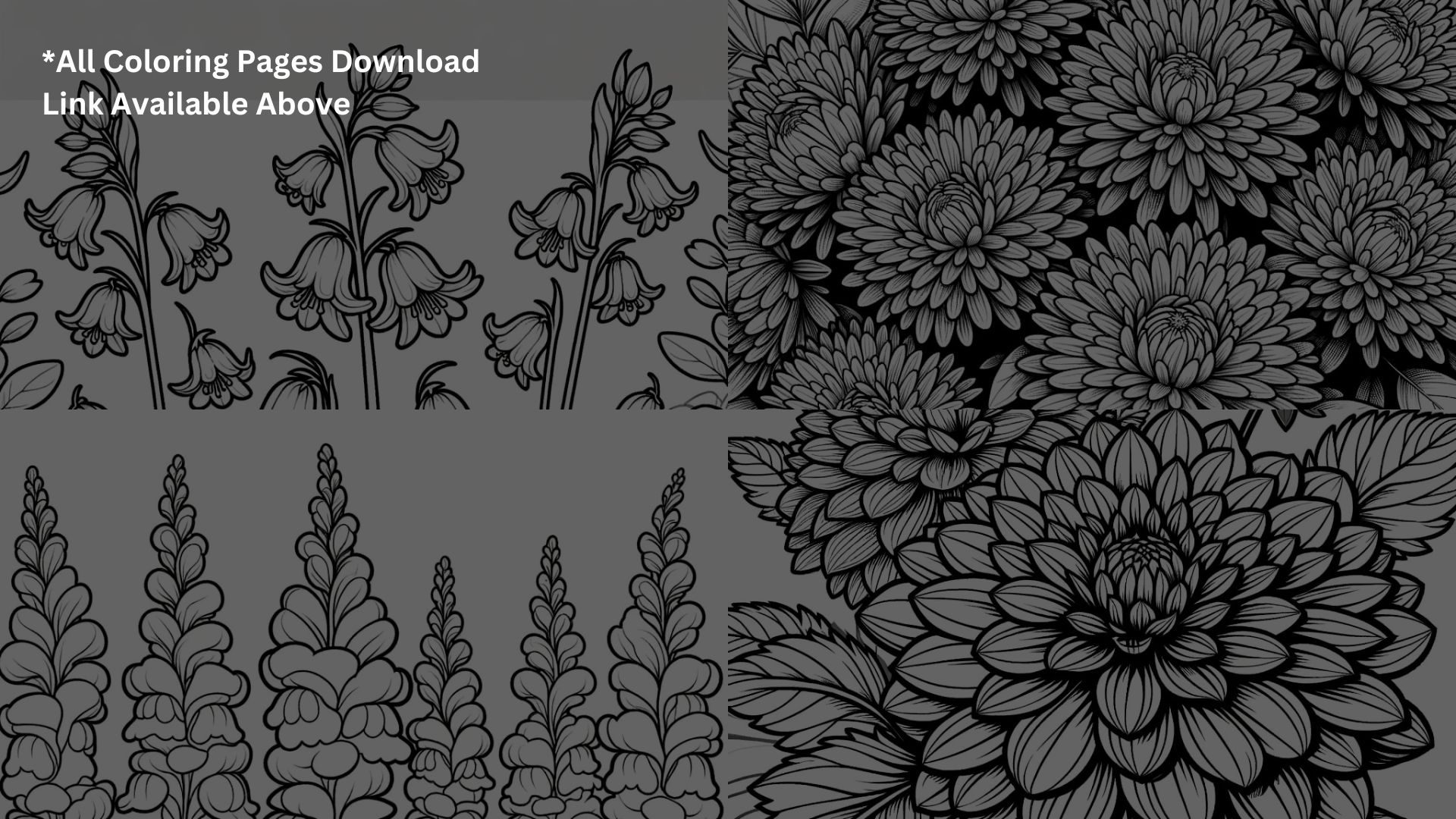
Welcome back to our floral wonderland, where each coloring page is a petal in our blooming bouquet of creativity! We’ve journeyed through 15 marvelous flowers, and now it’s time to add the final five to complete our set of 20. These last blooms are sure to captivate and challenge your little colorists in new and exciting ways. Let’s discover them!
- The Stately Dahlia: First in our final set is the dahlia. Known for its symmetrical beauty and layers of petals, the dahlia is a delight for children who love to dive into details. It’s a fantastic way to practice precision and patience in coloring.
- The Charming Snapdragon: Next, we meet the Snapdragon, a flower with a whimsical shape and varied hues. Its tall, clustered blooms are perfect for experimenting with vertical coloring techniques and gradient effects. It’s a playful addition to any coloring book.
- The Vibrant Aster: The aster, with its star-shaped flowers and vivid colors, is an invitation to explore the universe of color. It’s an excellent page for kids who enjoy creating lively, dynamic artwork with a mix of bright hues.
- The Graceful Bluebell: Then we have the bluebell, a symbol of constancy and everlasting love. Its delicate, bell-shaped flowers offer a chance to play with shades of blue and purple, adding a cool, serene touch to your child’s collection.
- The Festive Poinsettia: Lastly, the poinsettia, often associated with holiday cheer, brings our garden to a joyful conclusion. Its broad, red leaves and small, central flowers present an opportunity to experiment with bold reds and greens, perfect for practicing festive coloring.
And there you have it, our collection of 20 flower coloring pages! Each one is a unique canvas, inviting your child to express themselves through the vibrant language of colors. We hope these pages spark joy, creativity, and a deeper appreciation for the beauty of nature in your young artists.
Conclusion
As we close our colorful chapter on flower coloring pages, remember, that each page is more than just a fun activity; it’s a journey of creativity and learning for your child. These 20 floral wonders are not just to color but to explore, imagine, and grow. So, keep those crayons ready, and let your little artists blossom with every page they color. Here’s to days filled with vibrant colors and happy memories. Happy coloring!
FAQs
- Q: What age is appropriate for flower coloring pages? A: Flower coloring pages are suitable for kids of all ages, starting as young as toddlers. For younger children, choose simple designs like daisies or sunflowers, and for older kids, intricate patterns like roses or orchids can be more engaging.
- Q: How can I print flower coloring pages at home? A: You can easily find and print flower coloring pages online. Just search for ‘printable flower coloring pages,’ choose your designs, and use a standard printer with paper. Ensure your printer settings are correct for the best quality print.
- Q: Are there any online resources for free flower coloring pages? A: Absolutely! Numerous websites are offering free printable flower coloring pages. Websites like Crayola.com, SuperColoring.com, and DLTK-kids.com are great places to start.
- Q: How can I make coloring a regular part of my child’s routine? A: Set aside a specific ‘coloring time’ each day or week. Keep coloring materials easily accessible and create a comfortable coloring space. You can also incorporate coloring into educational activities, like learning about different types of flowers.
- Q: What are some creative ways to display my child’s coloring pages? A: You can create a mini art gallery on a wall in your home, use a bulletin board, or frame their best works. Another fun idea is to create a coloring book by binding their colored pages together, showcasing their progress and creativity.






